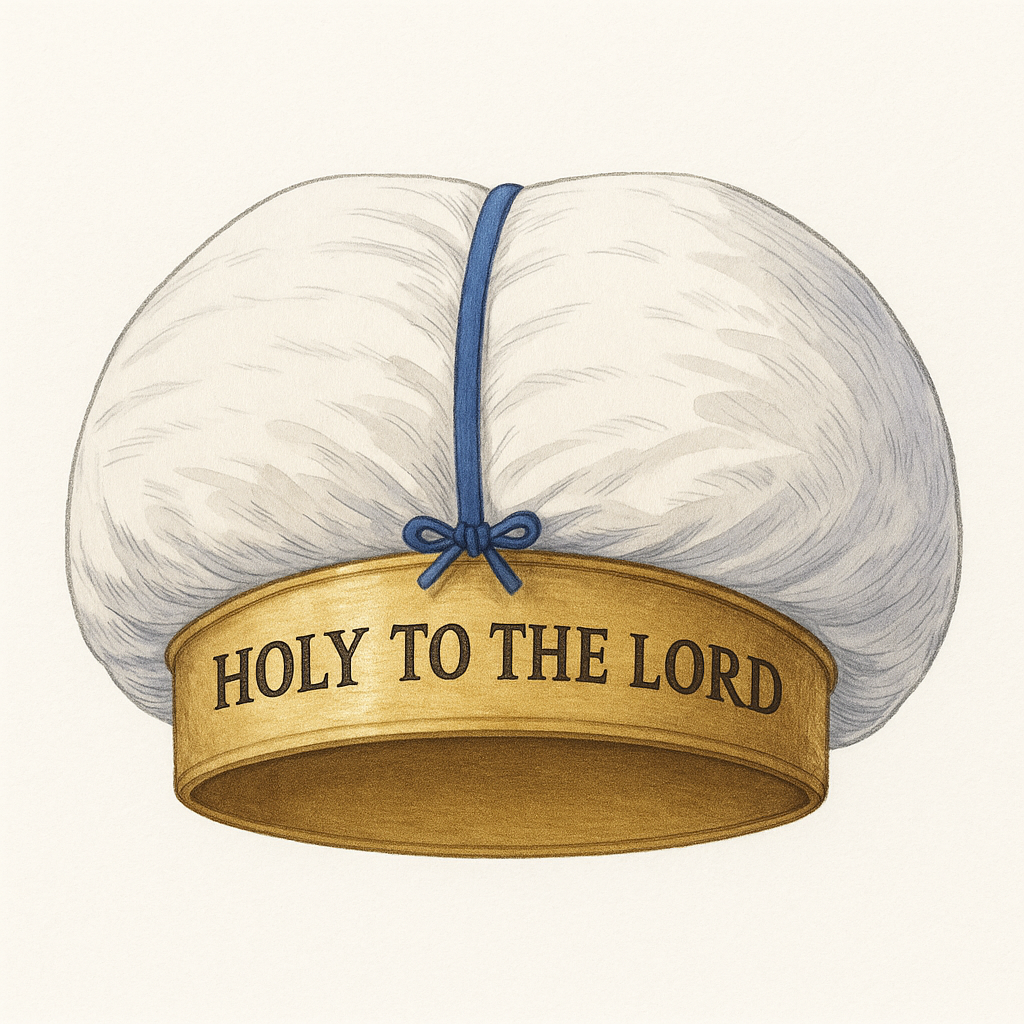Priests
In the late 90s, the artist Mýa summarised how many of us today think about life and reality in her song “It’s All About Me”:
It's all about me me me me me
Forget about you you you you you
It’s a fairly self-indulgent song. Though not particularly well-known these days, it basically captures the “me-mindset” that we all adopt from time to time (if not all the time).
It’s all about me. Me me me me.
What’s the root of the problem? What’s the consequence? What’s the solution?
The root of the problem is sin. When we reject God and his design for the world, we have to replace him with another “god”. That God often ends up being ourselves.
The consequence of this problem is separation from God. We tell God that we don’t want him, and he gives us what we want. As a result, we’re disconnected from God. We’re cut off from his holy presence.
What’s the solution? It involves people who serve, and one man in particular.
Priests and Exodus
In the book of Exodus, God had a plan to shape the nation of Israel into a people set apart for his glory. In Exodus 19:6, God tells Israel that they would “be for me a kingdom of priests and a holy nation.” How would they become this holy nation and kingdom of priests? Part of the solution involved the office of “priest”.
God appointed priests to serve him in the tabernacle.
In Exodus 28:1, God said to Moses, “Have Aaron your brother brought to you from among the Israelites, along with his sons Nadab and Abihu, Eleazar and Ithamar, so they may serve me as priests.”
So, the priests were appointed by God, not by their skills, abilities, popularity or CVs.
Their job? To serve. They were to stand in the gap between a holy God and a sinful people. Later in Exodus, and in books such as Leviticus and Numbers, we learn more about how priests served in the tabernacle. They offered sacrifices like burnt offerings and sin offerings (Exodus 30, Leviticus 1–7). They served as mediators who represented the people before God, especially on the Day of Atonement (Leviticus 16:32–34). They were responsible for teaching God’s law (Leviticus 10:10–11), pronouncing God’s blessing on the people (Numbers 6:22–27) and guarding the holiness of the tabernacle (Numbers 18:1–7). Through these roles, they served to maintain Israel’s covenant relationship with a holy God.
Their bling? For now, we’re going to explore a bit about the bling God gave them to wear. In Exodus 28:2 we read, “Make holy garments for your brother Aaron, for glory and beauty.“ So, the bling is meant to be holy. It’s “separate” or “distinct” from what people usually wear. That’s not surprising, given that Israel is meant to be a “holy” nation, and the priests are representative leaders of this holy nation. They are meant to be glorious, reflecting the fact that God is glorious (see Exodus 24:16-17 in particular). The bling is beautiful as well. We see this in the description that follows.
Here’s a picture of the bling, courtesy of the ESV Study Bible.
Let’s break this outfit down.
The Ephod (28:6-8)
First up, we have the ephod. This is the sleeveless, blue and purple apron-like-vest thing. It was made with blue, purple, and scarlet yarn and woven with gold. It had two shoulder pieces and a waistband, and it supported the breastpiece. We want to be careful about reading too much into the colours. I struggle to see any significance in the colour blue, other than it looks cool. Purple gives royal vibes (Judges 8:26, Esther 8:15, John 19:2-3), scarlet gives atonement vibes (Isaiah 1:18), and gold gives vibes of royalty and glory.
The Onyx Stones (28:9-14)
Then, God commands that two onyx stones be engraved with the names of Israel’s twelve tribes and placed on the high priest’s shoulders. Onyx is a precious stone, and there was heaps of it in the Garden of Eden (Genesis 2:12), so maybe this is meant to point us back to what things were like when God’s people were in perfect relationship with him. The fact that the names of the twelve tribes were engraved on the stones suggests that the priests carried the tribes of Israel on their shoulders as they served. The “filigree settings” are like decorative gold chains made of finely twisted threads of gold (or another precious metal), used to hold the onyx stones in place. There was lots of gold in Genesis 2:12 too.
The Breastpiece (28:15-30)
The breastpiece was a square garment worn over the priest’s heart. It had twelve precious stones attached, each representing the twelve tribes of Israel, again, a symbol that the priest was repping all of Israel. Twelve precious stones existed in the Garden of Eden (see Ezekiel 28:13) and will be a feature in the new heavenly Jerusalem (Revelation 21:19–20; note that a few of the stones are different, but most are the same). The breastpiece also contained these weird objects called the Urim and Thummim, which were used to seek God’s guidance in matters of national decision. These were positioned over the priest’s heart so that he ”will always bear the means of making decisions for the Israelites over his heart before the LORD” (Exodus 28:30).
The Robe (28:31-35)
The robe was the big blue thing under the ephod. The robe had bells and pomegranates woven into the hem (the bottom edge of the robe). Verse 35 tells us explicitly why there were bells: “The sound of the bells will be heard when he enters the Holy Place before the LORD and when he comes out, so that he will not die.“ No explanation is given for the pomegranates, but we know that they were a symbol of “the good life” (see Deuteronomy 8:8, Numbers 20:5). FWIW, my friend Russell used to really like pomegranates.
The Gold Plate and Turban (28:36–39)
God instructs for a gold plate to be made, engraved with the words "Holy to the LORD" (but in Hebrew). It was then attached to the priest’s turban. It reminded the priest that the LORD is holy, and that he and his nation should strive to be holy. In verse 38, we’re told explicitly why the priest had to wear this: “It will be on Aaron’s forehead continually so that they will be acceptable to the LORD.” It reminded Israel that the LORD is holy and that those who serve him must also be holy.
Undergarments (28:42-43)
Then, finally, there were the undergarments made of fine linen (so probably white in colour). Holiness on the outside wasn’t the only thing that mattered—the bottom layers mattered too. In verse 43, we’re told why: “Aaron and his sons must wear them whenever they enter the tent of meeting or approach the altar to minister in the Holy Place, so that they will not incur guilt and die.“ God’s people can’t approach a holy God on our own terms. They have to approach him on his terms.
Joining the Threads Together
Now, what’s the point of all of this? Why so many details? The basic point still stands:
God appointed priests to serve him in the tabernacle.
The high priest was a living symbol of God’s holiness, representing his desire to dwell among his people and be known by them.
In Exodus 28, we’re shown that this job—representing the holy people of the holy God—is so important that it required a beautiful and glorious outfit.
2. Priests and Jesus
The book of Hebrews picks up this theme of priesthood and shows us how it ultimately points to Jesus, especially in chapter 5. In a nutshell, we see that God appointed Jesus as High Priest to serve him and save us.
Hebrews 5:1 says, “Every high priest is selected from among the people and is appointed to represent the people in matters related to God.” That was Aaron’s role in Exodus. We’re also told that the human priests were “subject to weakness” (5:2) and had to make sacrifices for their own sins (5:3), because they sinned.
Jesus is different. Jesus was appointed by the Father to serve as our everlasting High Priest. In Hebrews 5:6, Jesus is described as “a priest forever, in the order of Melchizedek.”
Unlike the priests of old, Jesus was sinless. Yet he fully experienced our weakness (5:3).
He served humanity as our representative. But he went even further. Through His obedience and suffering, “He became the source of eternal salvation for all who obey him” (verse 9). That is, he came to serve and save.
How? Not through bling: he just wore normal clothes (John 19:2) and “had no beauty or majesty to attract us to him” (Isaiah 53:2). Not through offering daily sacrifices, either.
Rather, he was the sacrifice. He offered up himself. Once for all. And now, he lives to intercede for us as our great High Priest (Hebrews 7:25).
3. Priests and Us
And, what does this mean for us? Well, in 1 Peter 2:4–5, we read:
4 As you come to him, the living Stone—rejected by humans but chosen by God and precious to him—5 you also, like living stones, are being built into a spiritual house to be a holy priesthood, offering spiritual sacrifices acceptable to God through Jesus Christ.
Remember all that stuff about precious (non-living) stones before on the priests’ breastpiece? Jesus is the Stone, the living Stone, precious to God. We, likewise, are living stones. We’re not being fashioned into a breastpiece—we’re being built into a spiritual house. But it still has something to do with priests. We’re called a holy priesthood. We don’t offer animal sacrifices—we offer spiritual sacrifices. That’s how we serve.
So, just as God appointed priests to serve him in Exodus, and just as God appointed Jesus to serve him and save us, now God has appointed us as his royal priesthood, saved to serve.
Instead of a me-centred mindset, we now adopt a service mindset.
And what does this look like? How do we serve? There are several ways you could answer that. We serve God by loving him and loving people. We serve God by obeying his commands.
We’re also told what it means to serve God when the language of the “holy priesthood” comes up again in 2:9. There we read:
But you are a chosen people, a royal priesthood, a holy nation, God’s special possession, that you may declare the praises of him who called you out of darkness into his wonderful light.
We serve by declaring the praises of Jesus, the one who saved us, calling us out of darkness and into his wonderful light. We’re called to speak of how great and praiseworthy Jesus is, both in terms of who he is and what he’s done. In other words, we serve God as his holy priesthood by telling people about God and his gospel.
And how do we do this? In literally every context imaginable. But as a youth pastor who also has young kids, I should add that this definitely involves sharing the good news of God and his gospel with youth and kids! So, if you’re not already, you should get involved in youth and kids’ ministry at your church. I can’t think of many better ways to get involved in serving as God’s royal priesthood and declaring his praises.
Other articles in this series:
The Old Testament, Jesus and Us
Part 1. Law
Part 2. Festivals
Part 3. Covenants
Part 4. Tabernacle
Part 5. Priests
Part 6. Sacrifice
Part 7. Sabbath
Part 8. Intercession
Part 9. Glory
Disclaimer: I use Grammarly and ChatGPT to catch my typos. Let me know if they missed any.


